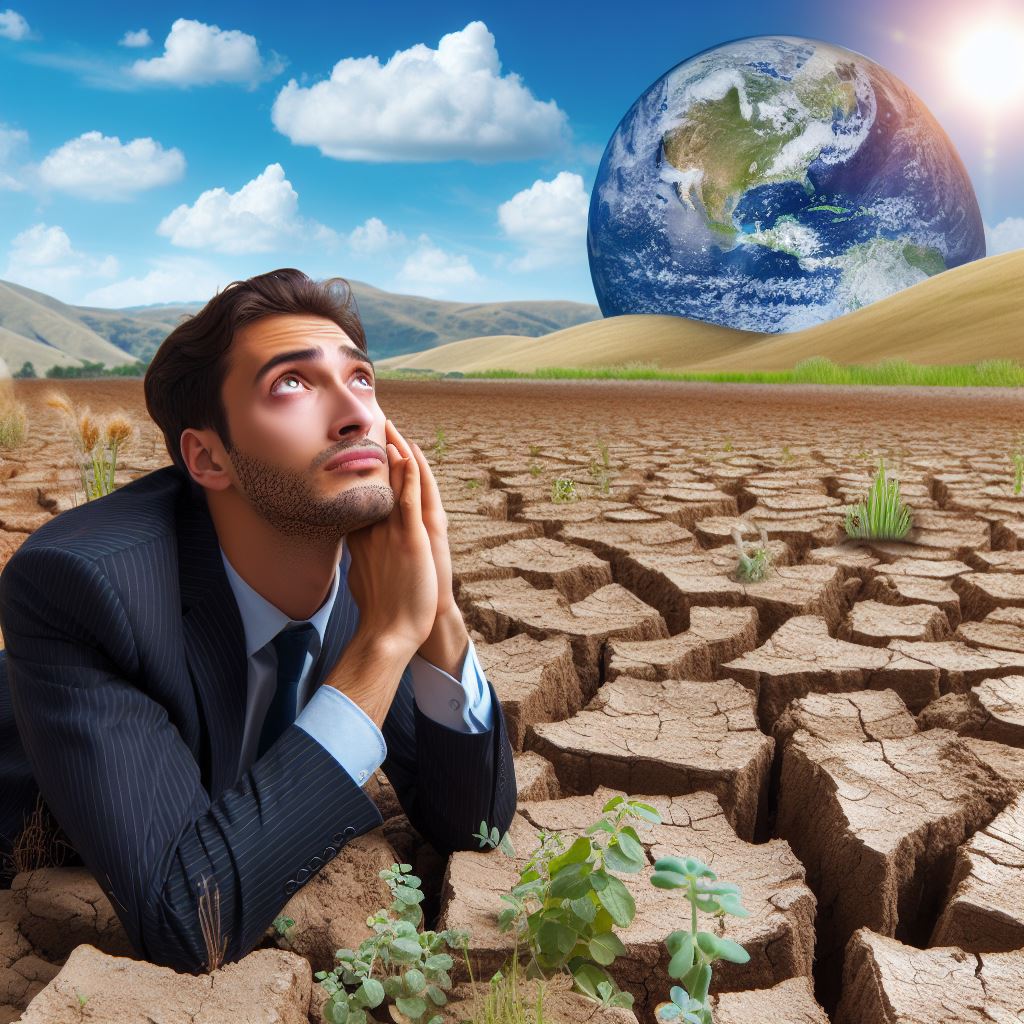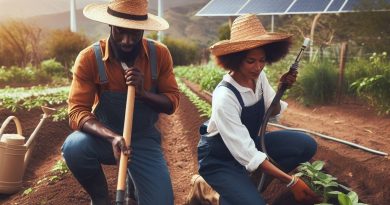Soil Conservation Techniques in Drought
Last Updated on March 2, 2024
Introduction
Soil conservation techniques play a crucial role in mitigating the effects of drought.
Soil is a valuable natural resource that supports plant growth and provides various ecosystem services.
Drought conditions can have a significant impact on soil health and fertility, leading to reduced agricultural productivity and environmental degradation.
In this blog post, we will explore the importance of soil conservation, discuss the specific impacts of drought on soil, and provide an overview of the topics covered in this section.
Importance of soil conservation
Soil conservation is essential for maintaining soil quality and ensuring sustainable agriculture.
It involves implementing practices to prevent soil erosion, improve water retention, and enhance soil organic matter content.
By conserving soil, we can preserve its structure, nutrient content, and microbial activity, which are crucial for plant growth and ecosystem functioning.
Impact of drought on soil
Drought exacerbates soil degradation processes by increasing the vulnerability of soil to erosion, compaction, and nutrient loss.
In the absence of adequate rainwater, soil particles become loose and susceptible to being carried away by wind or water.
This erosion not only results in the loss of valuable topsoil but also leads to sedimentation in rivers and streams, impairing water quality and aquatic habitats.
Overview of the blog post
Through this blog post, we aim to provide valuable insights into the best soil conservation practices for drought-prone areas.
We will explore techniques such as conservation tillage, cover cropping, mulching, and terracing, among others.
Additionally, we will discuss the importance of crop rotation, proper irrigation management, and the use of organic amendments to improve soil resilience and moisture retention capacity.
By implementing these soil conservation techniques, farmers and landowners can protect their soils from the detrimental effects of drought, enhance agricultural productivity, and contribute to environmental sustainability.
So join us in the upcoming sections as we dive deeper into each of these soil conservation practices and learn how to preserve this precious resource in the face of drought challenges.
Understanding drought
Definition and causes of drought
Drought can be defined as a prolonged period of abnormally low rainfall, resulting in a shortage of water.
It can be caused by various factors such as low precipitation, high temperatures, or changes in weather patterns.
- Low precipitation: A lack of rainfall is the primary cause of drought. When there is a shortage of water, it affects the soil moisture content and leads to drought conditions.
- High temperatures: Excessive heat can increase evaporation rates, causing moisture to evaporate from the soil. This leads to a decrease in soil moisture levels, contributing to drought.
- Changes in weather patterns: Climate change can alter weather patterns, leading to reduced rainfall. This shift in precipitation patterns can result in prolonged drought conditions.
Effects of drought on soil health
Drought has significant detrimental effects on soil health, compromising its fertility and overall productivity.
These effects include:
- Decreased soil moisture: Drought reduces soil moisture content, making it challenging for plants to absorb water and nutrients. This limitation negatively impacts crop growth and productivity.
- Soil crusting: In drought conditions, the soil surface dries out and forms a hard crust, making it difficult for plant roots to penetrate and access nutrients.
- Soil compaction: With reduced moisture, the soil becomes more compacted, affecting its ability to hold water and sustain plant growth.
- Nutrient depletion: Drought can accelerate nutrient leaching, washing away essential elements from the soil. This depletion reduces soil fertility and hinders plant growth.
Link between drought and erosion
Drought and erosion are interconnected processes that strengthen each other.
The relationship between drought and erosion includes the following aspects:
- Loss of vegetation cover: Drought weakens plants, causing them to die or go dormant. This loss of vegetation cover leaves the soil exposed, making it susceptible to erosion by wind and water.
- Reduced soil stability: Drought leads to dry and compacted soil, which loses its structural stability. This makes it easier for wind and water to erode the soil, washing away valuable topsoil.
- Increased runoff: Drought reduces infiltration rates, making the soil less capable of absorbing water. As a result, surface runoff increases, leading to erosion and soil loss.
- Soil nutrient loss: Erosion during drought events can result in the loss of nutrient-rich topsoil. This nutrient loss further exacerbates the adverse effects of drought on soil health and reduces fertility.
Basically, understanding drought is crucial for implementing effective soil conservation techniques.
Drought, caused by factors like low precipitation and high temperatures, negatively affects soil health.
It leads to decreased soil moisture, soil crusting, compaction, and nutrient depletion.
Additionally, drought and erosion are closely linked, with the loss of vegetation cover, reduced soil stability, increased runoff, and soil nutrient loss further intensifying the negative impacts.
To combat the adverse effects of drought on soil, implementing proactive soil conservation measures becomes essential.
Read: Climate-Proof Crops: The Genetic Engineering Angle
Soil Conservation Techniques in Drought
Droughts can have devastating effects on agriculture and the environment.
Soil conservation techniques are vital in mitigating the impacts of droughts and ensuring sustainable farming practices.
By implementing water management practices and adopting sustainable farming methods, farmers can better protect their soil and crops during periods of water scarcity.
Water management practices
Water management practices play a crucial role in soil conservation during droughts.
Efficient irrigation systems, such as drip irrigation or precision sprinklers, deliver water directly to the roots with minimal evaporation or runoff.
This ensures that crops receive adequate watering while minimizing water wastage.
By using advanced technologies and monitoring techniques, farmers can optimize water usage and reduce their reliance on scarce water resources.
Mulching is another effective technique for soil conservation during droughts.
Applying a layer of mulch, such as straw, wood chips, or compost, around plants helps retain moisture in the soil by reducing evaporation.
Mulch also acts as a barrier against extreme temperatures, protects soil structure from erosion, and suppresses weed growth.
This technique significantly reduces the water requirements for crops, making it a valuable practice in areas experiencing water scarcity.
Rainwater harvesting is gaining popularity as a sustainable solution during droughts.
By collecting and storing rainwater, farmers can have a supplementary water source for irrigation when rainfall is scarce.
This technique involves capturing rainwater through systems like rooftop collectors or underground tanks.
Stored rainwater can be used during dry spells, reducing reliance on traditional water sources and minimizing the impact of droughts on farming operations.
Sustainable farming practices
Sustainable farming practices also contribute to soil conservation in drought-prone areas.
Conservation tillage is a technique that minimizes soil disturbance, leaving crop residues on the surface to protect the soil from erosion.
This practice enhances soil moisture retention, promotes root development, and reduces the risk of nutrient loss.
Conservation tillage systems like no-till or reduced tillage help maintain the soil structure and minimize water loss during drought conditions.
Cover cropping is another sustainable farming practice that can improve soil conservation in droughts.
Planting cover crops, such as legumes or grasses, during fallow periods or overwintering seasons helps protect the soil from erosion and enhances organic matter content.
Cover crops also improve soil fertility, increase microbial activity, and contribute to groundwater recharge.
These benefits make cover cropping an effective strategy for mitigating the effects of drought and maintaining soil health.
Crop rotation is a time-tested method for sustainable farming that offers multiple benefits, including better drought resilience.
By alternating the types of crops grown in a field, farmers can break pest cycles, control weed populations, and manage nutrient depletion.
Additionally, different crops have varying water requirements, which allows for water conservation during dry periods.
Crop rotation helps improve soil structure, boost organic matter, and increase its capacity to withstand drought stress.
Generally, soil conservation techniques play a vital role in mitigating the effects of drought on agriculture.
Implementing water management practices, such as efficient irrigation systems, mulching, and rainwater harvesting, can significantly reduce water usage and protect soil moisture during periods of water scarcity.
Sustainable farming practices, including conservation tillage, cover cropping, and crop rotation, contribute to soil health, enhance drought resilience, and promote long-term sustainability.
By adopting these techniques, farmers can better cope with drought conditions while ensuring the productivity and longevity of their land.
Read: Carbon Farming: Agriculture’s Climate Promise

Explore Further: US Agri-Climate Policy: Boon or Bane for Farmers?
Importance of Soil Biology in Drought Conditions
Soil biology plays a crucial role in ensuring soil health and its ability to withstand drought conditions.
By promoting soil microbiology, farmers and land managers can improve soil fertility, water-holding capacity, and overall productivity.
Promoting Soil Microbiology
Adding organic matter to the soil is an effective way to increase its biological activity.
Organic matter acts as a food source for soil microorganisms, encouraging their growth and activity.
This, in turn, improves soil structure, nutrient cycling, and water retention.
Organic matter can be added through the incorporation of crop residues, animal manure, or green manure cover crops.
Biofertilizers are another valuable tool in promoting soil microbiology.
Biofertilizers contain beneficial microorganisms such as bacteria, fungi, or algae that help enhance soil fertility and nutrient absorption by plants.
These microorganisms can fix atmospheric nitrogen, solubilize phosphorus, and increase the availability of other essential nutrients.
Using biofertilizers reduces the need for synthetic fertilizers, helping to minimize chemical inputs and their potential environmental impacts.
Composting is a natural process that transforms organic waste, such as kitchen scraps or yard trimmings, into nutrient-rich compost.
Compost can be applied to agricultural or garden soils to improve their structure, water-holding capacity, and nutrient availability.
Composting also reduces waste volume and helps recycle nutrients back into the soil. When applied regularly, compost can significantly enhance soil biology and resilience to drought.
Enhancing Soil Structure
Vermiculture, or the use of earthworms to decompose organic matter, is an effective method for enhancing soil structure.
Earthworms consume and break down organic matter, creating tunnels and channels in the soil.
These channels improve soil aeration, water infiltration, and drainage, making the soil more resilient to drought.
Vermiculture also enriches the soil with worm castings, which are nutrient-rich excreta produced by earthworms.
No-till farming, also known as zero tillage or direct seeding, is a practice where crops are grown without disturbing the soil through plowing or tilling.
By leaving the soil undisturbed, the natural soil structure is preserved, and the soil’s ability to retain moisture during droughts is enhanced.
No-till farming also reduces erosion and improves soil organic matter content over time.
Microbial inoculants are products that contain specific strains of beneficial microorganisms.
These microorganisms can be added to the soil to enhance nutrient availability and soil structure.
For example, certain bacteria can fix atmospheric nitrogen and make it available to plants, while mycorrhizal fungi improve nutrient uptake by forming symbiotic relationships with plant roots.
By introducing microbial inoculants, farmers can improve soil health and reduce the reliance on synthetic fertilizers.
Therefore, soil biology and its management are of paramount importance in drought conditions.
Promoting soil microbiology through organic matter addition, biofertilizers, and composting can improve soil fertility and nutrient cycling.
Enhancing soil structure using techniques like vermiculture, no-till farming, and microbial inoculants helps preserve soil integrity and water-holding capacity.
By focusing on soil biology, farmers can build resilient agricultural systems that can withstand and recover from droughts more effectively.
Read: Pest Patterns: Climate Change’s Unseen Effect
Implementing soil conservation techniques
Farmer education and awareness
One of the primary steps in implementing soil conservation techniques is to provide farmers with the necessary education and awareness.
Workshops and training programs can play a vital role in educating farmers about the importance of soil conservation and showcasing effective techniques.
These initiatives can be organized by agricultural extension agencies, research institutions, or non-profit organizations.
By conducting workshops and training programs, farmers can be trained on various soil conservation practices.
Expert agronomists, soil scientists, and conservation specialists can be invited to educate farmers about erosion control, water management, conservation tillage, cover cropping, and other relevant techniques.
These programs should be tailored to the specific needs and challenges faced in drought-prone regions.
Sharing success stories and case studies of farmers who have successfully implemented soil conservation techniques can be inspiring and motivating for others.
These stories can be shared through websites, newsletters, magazines, or even community gatherings.
By highlighting the benefits and positive outcomes achieved through soil conservation, more farmers can be encouraged to adopt these practices.
Government support and incentives
Government support and incentives play a vital role in encouraging farmers to implement soil conservation techniques.
Financial assistance and policy frameworks can provide the necessary resources and guidance for farmers to adopt sustainable practices.
Governments can provide financial assistance to farmers for investing in soil conservation measures.
This assistance can take the form of grants, subsidies, or low-interest loans for purchasing conservation equipment, implementing land management practices, or adopting new technologies.
Financial incentives can encourage farmers to overcome financial barriers and prioritize soil conservation.
Governments can develop and implement policy frameworks that prioritize and promote soil conservation practices.
These frameworks can include regulations, guidelines, and incentives for farmers to adopt sustainable agriculture practices.
Policies can also address land use planning, irrigation management, and water conservation to complement soil conservation efforts.
Collaboration between government departments, agricultural bodies, and environmental agencies is crucial for the successful implementation of these policies.
In general, implementing soil conservation techniques in drought-affected regions requires a multi-faceted approach involving farmer education, awareness, and government support.
Through workshops, training programs, success stories, and financial assistance, farmers can be empowered to adopt sustainable practices and contribute to long-term soil preservation and agricultural resilience in drought conditions.
Read: Floods & Agriculture: Preparing for the Surge
Find Out More: Impact of Green Laws on US Agriculture Sector
Conclusion
Recap of key points discussed in the blog post
Throughout this blog post, we explored various soil conservation techniques in drought-prone regions.
We discussed the importance of implementing these techniques to ensure sustainable agriculture and overcome the challenges posed by drought.
Emphasize the importance of soil conservation in drought
Soil conservation plays a crucial role in mitigating the effects of drought on agriculture.
By implementing these techniques, farmers can maintain soil fertility, prevent erosion, and enhance water retention, thus ensuring crop productivity even in dry spells.
Encouragement to implement these techniques for sustainable agriculture in drought-prone regions
It is imperative for farmers and agricultural communities to adopt these soil conservation techniques.
By doing so, they can create resilient farming systems that are better equipped to handle droughts, secure food production, and protect the environment for future generations.
Overall, understanding and implementing soil conservation techniques in drought-prone regions is vital.
Sustainable agriculture practices not only ensure food security but also promote environmental sustainability.
Let us all take the necessary steps to conserve soil, protect our resources, and build a resilient agricultural sector amidst challenging drought conditions.
Together, we can make a significant difference in achieving sustainable development.


